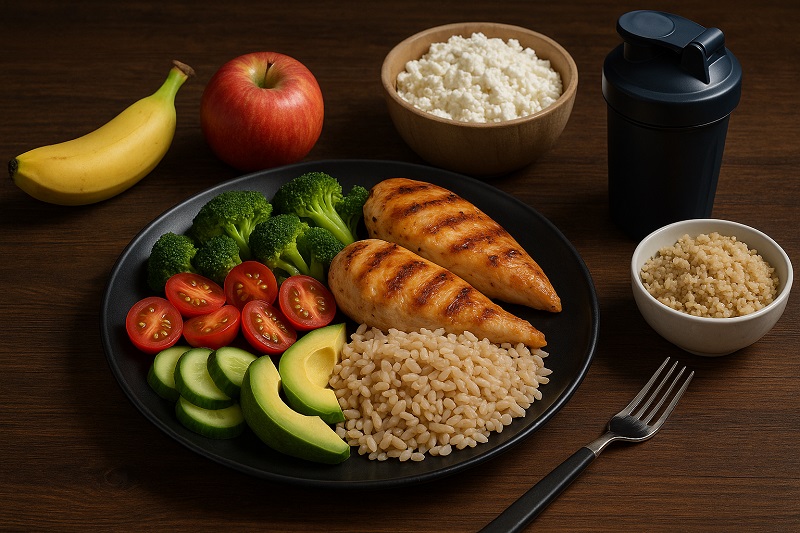Healthy Meal Plans for Athletes: Fuel Your Performance

Ever wonder what separates good athletes from great ones? It’s not just training—it’s what’s on their plate. The right meal plan can boost your energy, speed up recovery, and push your performance to new heights. In this guide, you’ll learn how to craft healthy meal plans tailored for athletes, with practical tips to fuel your body like a pro. Ready to eat your way to victory?
Why Nutrition is Your Secret Weapon
Think of your body as a high-performance car. You wouldn’t pour soda into a Ferrari’s tank, right? Athletes need premium fuel—nutrients that power intense workouts and repair muscles. A 2023 study in Sports Medicine found that optimized nutrition can improve endurance by 15% and strength by 10%. That’s the difference between a podium finish and an “almost.”
Take Mia, a marathon runner who kept hitting the wall at mile 18. She revamped her diet, prioritizing carbs and protein, and smashed her personal record. Nutrition isn’t just food—it’s strategy.
The Core of an Athlete’s Meal Plan
So, what should you eat? It’s all about balance: carbs for energy, protein for muscle repair, and fats for sustained fuel. But it’s not one-size-fits-all. A sprinter needs different macros than a triathlete. That’s where tools like the Macro Calculator come in—plug in your stats, and it spits out personalized targets. No guesswork, just results.
Here’s the breakdown. Carbs should make up 50-60% of your calories—think oats, sweet potatoes, or quinoa. Protein? Aim for 20-30%, from sources like chicken, eggs, or tofu. Fats, around 20%, come from avocados, nuts, or olive oil. Timing matters too. Eat a carb-heavy meal 2-3 hours before training to stock your energy reserves.
Sample Meal Plan for a Training Day
Let’s get practical. Imagine you’re a cyclist prepping for a long ride. Here’s what a day of eating might look like.
Start with breakfast: a bowl of oatmeal topped with berries, a scoop of Greek yogurt, and a drizzle of honey. It’s a carb-protein combo that fuels your morning session. Mid-morning, snack on a banana and a handful of almonds—quick energy, no crash. For lunch, go for grilled chicken, quinoa, and a pile of roasted veggies with olive oil. Post-workout, blend a smoothie with whey protein, spinach, and a frozen mango. Dinner? Salmon, sweet potato wedges, and steamed broccoli. If you’re peckish later, grab a slice of whole-grain toast with almond butter.
This plan keeps your energy steady, repairs muscles, and tastes damn good. Adjust portions based on your needs—use the Macro Calculator to nail the numbers.
Game-Changing Tips for Meal Prep
Who’s got time to cook gourmet meals every day? Not you, probably. Meal prepping is your lifeline. Spend a Sunday chopping veggies, grilling protein, and batch-cooking grains. Store it in containers, and you’re set for the week. Pro tip: keep flavors fresh with spices—paprika on chicken, cumin on roasted chickpeas. Boring meals kill motivation.
Hydration’s non-negotiable too. Dehydration can tank your performance by 10%, per a Journal of Athletic Training study. Aim for 2-3 liters of water daily, more if you’re sweating buckets. Electrolyte drinks? Save ‘em for sessions over an hour.
Eating for Different Sports
Not every athlete eats the same. A weightlifter needs more protein to pack on muscle—think 1.6-2.2 grams per kilo of body weight. Endurance runners lean on carbs, sometimes up to 70% of their diet, to sustain long efforts. Team sport athletes, like soccer players, need a mix: carbs for sprints, protein for recovery, fats for stamina.
Here’s a story. Alex, a basketball player, used to carb-load like a marathoner. He felt sluggish. After tweaking his diet to balance protein and fats, his explosiveness on the court soared. Moral? Know your sport, know your plate.
Pre- and Post-Workout Nutrition
Timing’s everything. Before a workout, you want fast-digesting carbs and a bit of protein—think a rice cake with peanut butter 30 minutes prior. Post-workout, your muscles are screaming for repair. Within 30-60 minutes, eat a 3:1 carb-to-protein combo, like a turkey sandwich on whole-grain bread or a protein shake with fruit.
Ever tried chocolate milk after a run? It’s not just nostalgia—it’s got the perfect carb-protein ratio. Science backs it, and it’s cheaper than fancy recovery shakes.
Common Mistakes to Avoid
Even the best athletes trip up. Skipping breakfast? You’re starting your day in an energy deficit. Overdoing protein shakes? They’re supplements, not meals. And don’t fall for “low-carb” hype—athletes need carbs to perform, not just survive.
Another trap: ignoring micronutrients. Vitamins and minerals, like iron from spinach or magnesium from nuts, keep your body humming. Skimp on them, and you’ll feel it—fatigue, cramps, the works.
Why You’ll Stick With It
Eating like an athlete isn’t about restriction—it’s about empowerment. Picture this: you’re crushing your workouts, recovering faster, and feeling like you could take on the world. That’s what the right meal plan does. It’s not a diet; it’s a lifestyle.
Start small. Try one new meal this week, maybe that oatmeal bowl. Use the Macro Calculator to dial in your portions. You don’t need to be perfect—just consistent. Your body’s ready to perform. Are you?